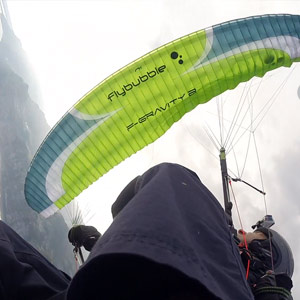
Acro paragliding looks exciting, but how do you learn to do it? What is a freestyle wing? And where are the best sites to try out the acro moves? Greg Hamerton discusses getting into acro on the Niviuk F-Gravity 2 and shares some hair-raising videos ...
I have been flying for over 20 years, and I'm comfortable doing reversals, SATs and full stalls. But the new wave of acro moves have been beyond my reach on the competition wing and small sites I fly.
That was easily sorted out: I bought a Niviuk F-Gravity 2, and I went to Lake Garda.
Because of my experience I was comfortable teaching myself, but I still made sure I had a lifejacket and two freshly packed reserve parachutes.
Prepare yourself for action
For most pilots, the best progression would be to first go on a Pilotage+SIV course, which teaches you to manage the energy of your wing and gives you a great foundation for building skills. You'll usually do wingovers, pitch control, spirals and refine your weight-shift control.
After flying for some time to master the Pilotage skills, attend a pure SIV course, which is more full-on and involves collapsing your wing in various ways and recovering. I recommend going on one every year until you're bored with fullstalls, spiral dives, auto-rotating asymmetric collapses, cravattes, and collapses on full speedbar. This builds reaction speed, familiarity with G-forces and an understanding of the aerodynamic effects.
Finally you're ready to go on an acro course, where it is assumed you know how to hit the kill switch (fullstall) and don't need to be told how to use your reserve or when to throw it. You'll also be on a smaller freestyle or acro wing, which has seriously powerful reactions.
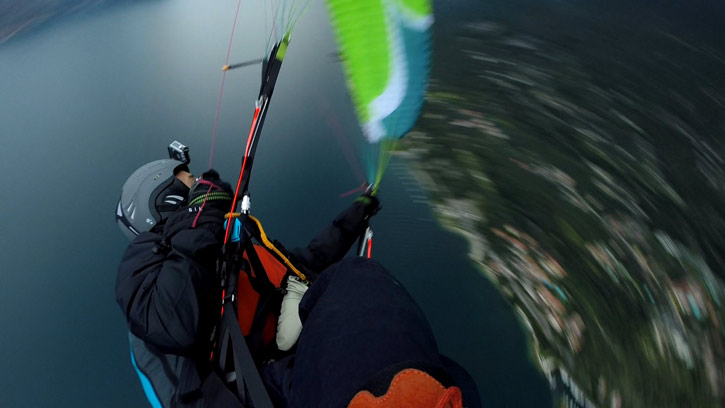
Verbier Summits offer courses at Lake Garda. Pal Takats (Lake Garda) and Max Marien (Oludeniz) have been known to offer courses in English, but it's a specialist niche so you'll need to check the latest offerings on the web.
All of these courses should be done very high over water, with a rescue boat.
Choosing the right equipment
In my case I chose the High Adventure Beamer 3 reserve parachute for its amazing opening speed, sink rate and for the steering capabilities. Many acro pilots use the Beamer, because it gives you the option of landing in the landing field instead of the water or bushes.
To increase my odds, I bought a simple reserve outer container and borrowed a second reserve from a friend. I only needed it for a short trip, and I was unlikely to use it. Having a reserve on the chest strap is a good idea because you can see it at all times and deployment is a one-pull move instead of the pull-it-out-then-swing-it-back deployment from a integrated container.
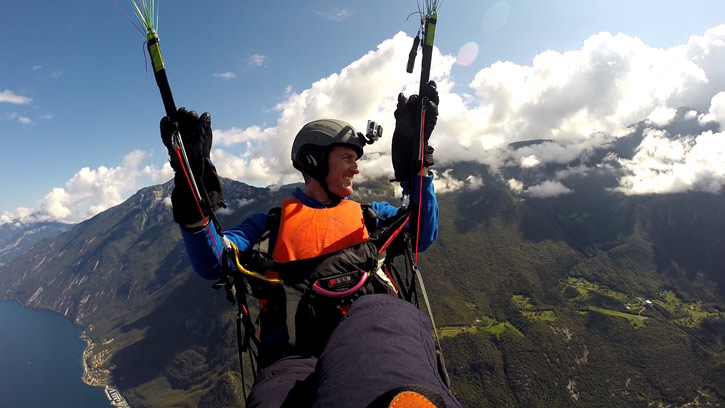
I used an Advance Success 3, which is a great general purpose harness. Make sure you have something strong enough - lightweight hike-and-fly harnesses are not designed to withstand the extreme forces of acro, and pod harnesses are not ideal because the prone position increases the risk of riser twists and limits weightshift control.
Getting an acro wing is a difficult decision because it's unlikely that you'll be able to demo one. Check out our range and call us for some expert advice.
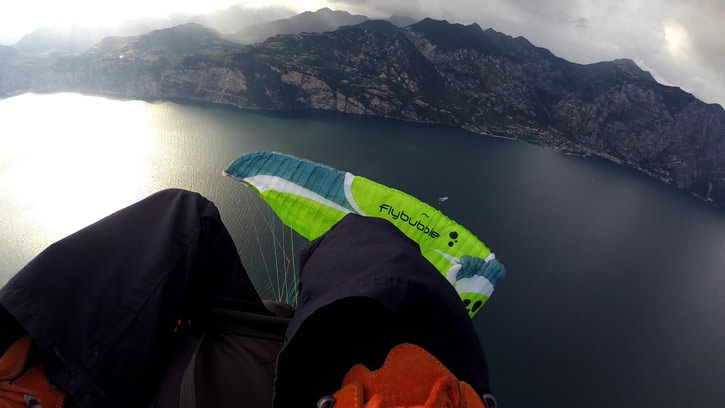
When acro wings come up on the second hand market, it's hard to know how badly they have been thrashed.
Unless you live near a big acro site it's probably not worth buying one - you can have a lot of fun on sporty wings like the Advance Sigma 9, Ozone Delta 2 and Skywalk Tequila 4. But if you're determined to progress, and can afford to dedicate the time, you need to decide what kind of acro wing you want.
There are two kinds available: full-on sub-18m2 'pro acro' wings and the tamer 'freestyle' wings which offer something closer to a normal paraglider. If you've never had either, you definitely want the freestyle wing! One that has a very good reputation is the Niviuk F-Gravity 2 (Fgrav)
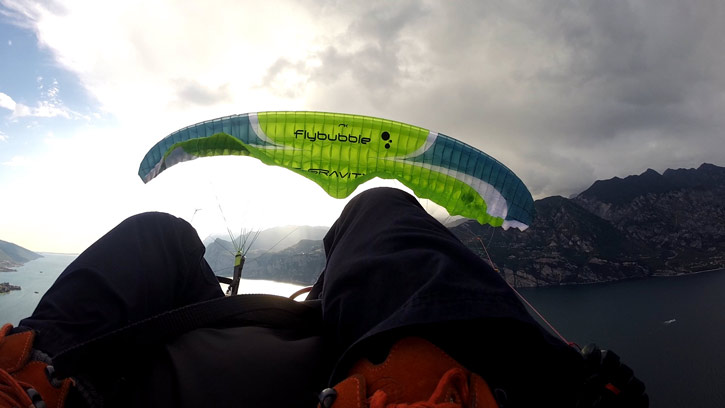
Can a freestyle wing replace my paraglider?
It depends on where you fly. If you have big mountain sites, you'll have a lot of fun on your freestyle wing. I thought I'd be able to use the Fgrav on my usual tiny windy UK ridge-soaring sites, to climb up and do a few moves. Not so. Although it's fun to slope-swoop, the higher sink rate means you don't get high enough to do acro if you're on small hills (<200m), and if you're soaring in stronger wind it's very risky to do anything where you might need your reserve. The trim speed isn't significantly higher than normal wings, and the speedbar isn't as stable as those found on modern XC wings. I guess it wasn't a priority when designing an acro wing. This means useable top speed is limited. For high-wind soaring I'm better off on my Icepeak 6. I found the same thing on the Advance Zeta.
So I tried it in thermic conditions instead (again, in the UK on little green hills). Unfortunately the Fgrav isn't good at climbing in weak thermals because it's hard work to stop a freestyle wing from banking over hard in the turns (that's what it's designed for). When thermals are strong it climbs well because it can turn very tightly, in the core.
So if you fly somewhere with booming thermals and nice big rock faces, you're in luck. If you're in the UK, a freestyle wing probably isn't going to replace your normal paraglider. It's a second wing.
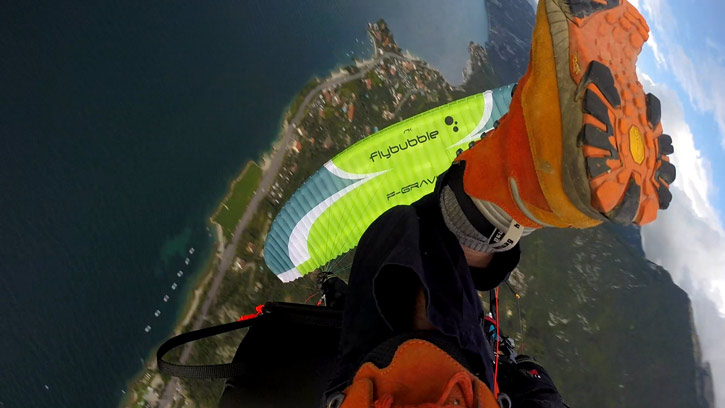
What can I expect from the F-gravity 2?
When you use it for what it's designed for, the Fgrav really shines. Although it says 22m2 on my wing, it looks and behaves as if it is a lot smaller than that. For pilots over 90kg all-up, this is the one to go for.
Wingovers: fun, big, predictable wingovers, easy to get the timing spot on, and produces a nice wing 'over' rather than the 'hook' turns of some other small wings
SAT: easy entry but much faster than a normal wing, with much more energy. As this is the foundation for many acro moves, it's a good thing, but I found the acceleration took some getting used to.
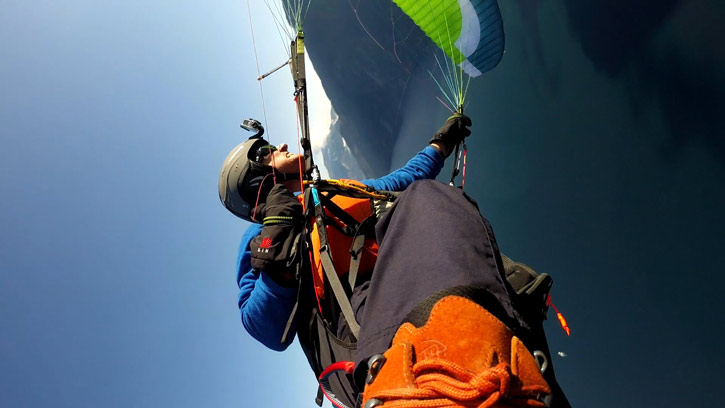
Helicopter: very hard to get the timing right, and the wing keeps trying to refly, but I've not managed to get a helicopter balanced on any wing, so it's a pilot problem
Stall recovery: lovely, just lovely. The Fgrav often helped me by pull out of stalls, it really wants to fly. It doesn't shoot too far ahead, and if you dampen out the dive it resists restalling nicely.
Asymetric spirals: builds up speed very quickly, the second turn puts the wing on the horizon.
Transition from SAT to spin: pilot needs work, but I found it difficult because the SAT is so fast, so there's a big step in speeds to get a spin. A good reason to go for a larger wing in the beginning.
When I over-turned a tumble or asymmetric SAT, the Fgrav saved my butt by losing energy nicely and pulling out manouevre. I'm sure there are other wings that would bite and shoot and create a hair-raising cascade from these extreme situations.
Overall, the F-Gravity 2 gets a big thumbs up from me for pilots entering acro.
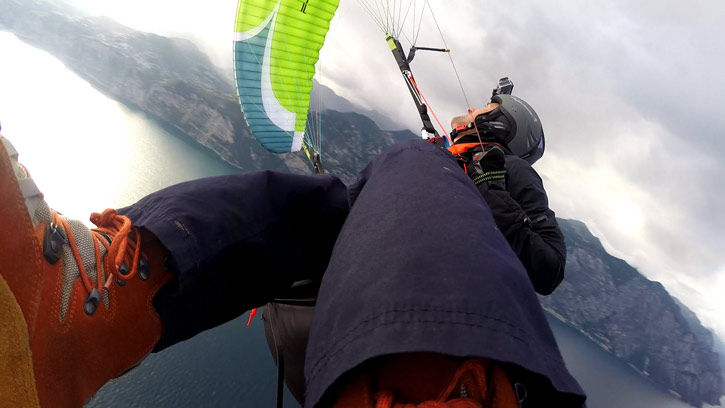
Practical considerations on doing acro
You need lots of altitude for this game. Find the biggest site you can, with the fastest turnaround time. I identified Lake Garda as the premiere acro site, with easy links via Verona airport and a good infrastructure. A campsite beside the landing field, a recently upgraded cable car with large capacity and high speed, a fresh water lake, and take-off at 1700m above landing.
The landing site is controlled by the friendly Paragliding Club Malcesine, so please follow their rules if you go there. It can get windy here so avoid the midsummer when there's a long queue for the cable car as well.
Unless you're doing acro a lot, the adrenalin, G force and disorientation are very tiring. Two runs a day was more than enough for me, but you could get four flights out of your 25 euro day pass on the cable car at Lake Garda.
Other sites to consider are Organya in Spain (acro over the ground, amazing afternoon valley release, lift everywhere), Gerlitzen in Austria (over fresh water, some recent licencing issues, do some research before going there), and Oludeniz in Turkey (world famous, over seawater, a long drive up to the site).
Why do acro paragliding?
Maybe this video will help you decide...
Brought to you by Flybubble
Want to see more? There’s no better way to support our efforts than buying gear from us. We’ll ensure you get great service! Choose from our great range AND enable us to produce more content to benefit the free flight community.
